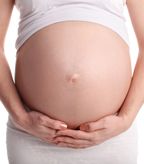Delaying Childbirth Could Reduce Risk of Triple-Negative Breast Cancer
The risk of triple-negative breast cancer appears to be lower for women who delayed childbirth and who chose to breast feed according to a new study.
Risk of triple-negative breast cancer appears to be lower for women who delayed childbirth and who chose to breast feed, according to a study published in Breast Cancer Research and Treatment. Researchers from the Fred Hutchinson Cancer Research Center used data from a population-based, case-control study of women who were between the ages of 20 and 44 to come to this conclusion.

Dividing women into those with each type of breast cancer (triple-negative, HER2-positive, and estrogen receptor [ER]-positive) and assessing relationships with various reproductive factors, the study shows those women whose first childbirth is delayed by at least 15 years after first menstrual period, age at first childbirth, and breastfeeding were all inversely associated with risk of triple-negative breast cancer (P value of .006, .002, and .018, respectively). The strong inverse link between breastfeeding and triple-negative breast cancer risk has been demonstrated in several previous studies and is the “most well-established protective factor” for triple-negative breast cancer, according to lead author Christopher I. Li, MD, PhD, of the Public Health Sciences Division at the Fred Hutchinson Cancer Research Center in Seattle, and colleagues. Breastfeeding was not positively or negatively associated with either ER-positive or HER2-positive breast cancers.
“Breast-feeding is emerging as a potentially strong protective factor against one of the most aggressive forms of breast cancer,” said Li, referring to triple-negative disease.
The mechanisms of how breast-feeding or delaying childbirth can protect against triple-negative breast cancer is largely unknown. For ER-positive disease, it is thought that hormones during pregnancy result in structural changes to the breast, making it less susceptible to this hormone-related breast cancer. For triple-negative breast cancer, changes to breast tissue and differentiation of terminal duct cells and not hormone effects are thought to influence breast cancer risk.
Because of the consistency that breast-feeding decreases triple-negative breast cancer, further studies to investigate the mechanisms involved are warranted, state the study authors.
For this study, researchers analyzed data and interviewed subjects from almost 2,000 women in the Seattle area who were between the ages of 20 and 44. The breast cancer and reproductive histories of 941 control subjects-781 ER-positive, 180 triple-negative breast cancer, and 60 HER2-positive women-were part of the study.
The results suggest that an increased age at first birth was associated with a reduced risk of the other breast cancer subtypes as well, but a statistically meaningful association was only found for triple-negative breast cancer.
Age at first menstrual period was not related to risk of any type of breast cancer. Increasing number of live births was associated with a reduced risk of all three types of breast cancer with a statistically significant association for ER-positive breast cancer (P = .015).
Those with ER-positive breast cancer tended to be older while those with triple-negative breast cancer were younger and more likely to be African American. Almost 10% of triple-negative breast cancer subjects were African American compared to 7% of those who were HER2-positive and 4.2% of those who were ER-positive. However, the number of subjects in each group was not large and the cohort had an over-representation of ER-positive breast cancers, reflecting the higher frequency of ER-positive breast cancer cases in the real world.
One possible explanation for the higher frequency of African American women diagnosed with TNBC may be linked to the outcome of this current study-African American women tend to have children at a younger age and also tend not to breast feed. Further studies are necessary, however, since there were not enough numbers of African American women in the current study to assess this hypothesis.
Triple-negative breast cancer is seen as a heterogeneous grouping of breast cancer subtypes, none of which overexpress HER2, are estrogen- and progesterone-receptor negative and therefore are not responsive to HER2-targeted or hormone-blocking drugs. Approximately 10% to 20% of all diagnosed breast cancers are triple-negative, which are typically more aggressive..
A Complicated Topic With Differing Conclusions
Reproductive factors are known risk breast cancer factors. The trouble is that different studies have come to different conclusions making it difficult to make full sense of this issue. One reason is that most studies lump all breast cancers together even though the biology and risk factors for each type differ. Breast cancers that are HER2-positive or triple-negative, for example, tend to occur more frequently among premenopausal women.
A large French study from 2002 by French National Institute for Health and Medical Research, published by the British Journal of Cancer, found that women who delay childbirth until their thirties have a 63% increased risk of premenopausal breast cancer compared to those who gave birth by the age of 22 and a 35% increased risk of postmenopausal breast cancer. The study analyzed 91,000 women who were between the age of 40 and 65.
A pooled analysis from 2002 found that the risk of premenopausal cancer is increased by 5% for each year that a women delays her first childbirth. This was based on pooled data of all breast cancer subtypes. According to the authors, six previous studies have assessed breast cancer risk by subtype. Four of these found that age at first childbirth was not associated with risk of any of the three breast cancer subtypes. Two found a positive association between age and luminal A breast cancer.
Study results may depend on the proportion of women who have given birth before and after age 30-older studies including fewer women who had their first child after the age of 30.
This complex issue will require much more research before any real conclusions can be made about how reproductive history relates to breast cancer risk.